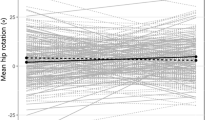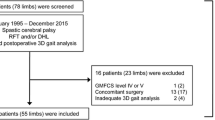Abstract
Purpose
To assess the outcome of children with cerebral palsy following reposition of the distal rectus femoris tendon for treatment of stiff knee gait.
Methods
Children with cerebral palsy with stiff knee gait who underwent rectus femoris transfer were studied retrospectively. Inclusion criteria were cerebral palsy of diplegic or quadriplegic type, preoperative and 1 year postoperative three-dimensional motion analysis, and no other surgery except rectus femoris transfer at the time of study. The patients were separated into two groups: in group I, the rectus femoris was transferred to the distal medial hamstring tendons, either the gracilis or the semitendinosus; in group II, the distal tendon of the rectus femoris was transposed laterally and attached to the iliotibial band/intermuscular septum.
Results
Peak knee flexion during swing phase, total dynamic knee range of motion, knee range of motion during swing phase, and time to peak knee flexion during swing phase were all improved in both groups. Hip and pelvic kinematics were not influenced by the surgery. Velocity, stride length, and cadence were all improved following the surgery. There was no difference between the transfer group and the transposition group.
Conclusion
These findings suggest that distal transfer of the rectus femoris is effective in improving swing phase knee function by diminishing the mechanical effect of the dysphasic swing phase activity of the rectus femoris, not by converting the rectus femoris to an active knee flexor.

Similar content being viewed by others
References
Gage JR, Perry J, Hicks RR, Koop S, Werntz JR (1987) Rectus femoris transfer to improve knee function of children with cerebral palsy. Dev Med Child Neurol 29(2):159–166
Perry J (1987) Distal rectus femoris transfer. Dev Med Child Neurol 29(2):153–158
Sutherland DH, Santi M, Abel MF (1990) Treatment of stiff-knee gait in cerebral palsy: a comparison by gait analysis of distal rectus femoris transfer versus proximal rectus release. J Pediatr Orthop 10(4):433–441
Chambers H, Lauer A, Kaufman K, Cardelia JM, Sutherland D (1998) Prediction of outcome after rectus femoris surgery in cerebral palsy: the role of cocontraction of the rectus femoris and vastus lateralis. J Pediatr Orthop 18(6):703–711
Delp SL, Ringwelski DA, Carroll NC (1994) Transfer of the rectus femoris: effects of transfer site on moment arms about the knee and hip. J Biomech 27(10):1201–1211
Miller F, Cardoso Dias R, Lipton GE, Albarracin JP, Dabney KW, Castagno P (1997) The effect of rectus EMG patterns on the outcome of rectus femoris transfers. J Pediatr Orthop 17(5):603–607
Rethlefsen S, Tolo VT, Reynolds RA, Kay R (1999) Outcome of hamstring lengthening and distal rectus femoris transfer surgery. J Pediatr Orthop B 8(2):75–79
Saw A, Smith PA, Sirirungruangsarn Y, Chen S, Hassani S, Harris G, Kuo KN (2003) Rectus femoris transfer for children with cerebral palsy: long-term outcome. J Pediatr Orthop 23(5):672–678
Ounpuu S, Muik E, Davis RB 3rd, Gage JR, DeLuca PA (1993a) Rectus femoris surgery in children with cerebral palsy. Part I: The effect of rectus femoris transfer location on knee motion. J Pediatr Orthop 13(3):325–330
Ounpuu S, Muik E, Davis RB 3rd, Gage JR, DeLuca PA (1993b) Rectus femoris surgery in children with cerebral palsy. Part II: A comparison between the effect of transfer and release of the distal rectus femoris on knee motion. J Pediatr Orthop 13(3):331–335
Riewald SA, Delp SL (1997) The action of the rectus femoris muscle following distal tendon transfer: does it generate knee flexion moment? Dev Med Child Neurol 39(2):99–105
Asakawa DS, Blemker SS, Gold GE, Delp SL (2002) In vivo motion of the rectus femoris muscle after tendon transfer surgery. J Biomech 35(8):1029–1037
Asakawa DS, Blemker SS, Rab GT, Bagley A, Delp SL (2004) Three-dimensional muscle-tendon geometry after rectus femoris tendon transfer. J Bone Joint Surg Am 86-A(2):348–354
Acknowledgment
The authors thank Kaye Wilkins for the friendly assistance.
Author information
Authors and Affiliations
Corresponding author
Additional information
No financial support was received for this study.
About this article
Cite this article
Hemo, Y., Aiona, M.D., Pierce, R.A. et al. Comparison of rectus femoris transposition with traditional transfer for treatment of stiff knee gait in patients with cerebral palsy. J Child Orthop 1, 37–41 (2007). https://doi.org/10.1007/s11832-006-0002-4
Received:
Accepted:
Published:
Issue Date:
DOI: https://doi.org/10.1007/s11832-006-0002-4




